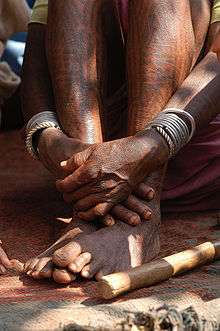Baiga tribe

Baiga is a tribe found in Madhya Pradesh and population 250,000, Uttar Pradesh, Chhattisgarh and Jharkhand states of India. The largest number of Baigas is found in Baiga-chuk in Mandla district and Balaghat district of Madhya Pradesh. They have sub-castes – Bijhwar, Narotia, Bharotiya, Nahar, Rai Bhaina, and Kadh Bhaina. Their population as of Census 2001/2011 was 390,000.
Practice of shifting cultivation
The Baiga tribes practice shifting cultivation in the forest areas. They say they never ploughed the Earth, because it would be akin to scratching the breast of their Mother, and they could never ask their Mother to produce food from the same patch of earth time and time again – she would have become weakened. For this reason, Baigas used to live a semi-nomadic life, and practiced Bewar, or 'dahiya' cultivation – out of respect, not aggression. These techniques, (also known as 'swidden' agriculture), rather than being a cause of deforestation, have been shown to be effective conservation devices, employed for centuries by tribal peoples.[1] Courageous woodsman and hunters,[2] the Baigas of Central India were reluctant to do work for others. They saw themselves as people of the forest, who could only live on the produce of the forest. It was below the dignity of a Baiga to become a labourer.
The Baiga culture

Members of the Baiga tribe do not interact even with other tribals like the Gonds, as interaction with any other tribe is a crime for them.
After a death in the family, the Baigas leave the house and build another one. Being dependent on the forest, they also do not engage in tendu patta collection, which is a major livelihood provider in Madhya Pradesh.
Tattooing tradition amongst Baigas

One of the tribes for whom tattooing is an integral part of their lifestyle is the Baiga tribe. This tribe inhabits the dense hilly forests in the eastern part of the Satpuras, in Shahdol, Bilaspur, Rajnandgaon, Mandla, and Balaghat districts. The Baigas are of Dravidian stock and are one of eight prime tribes of M.P.[3]
It is believed that this tribe is an offshoot of the Bhuiya tribe of Chhota Nagpur. A distinguishing feature of the Baiga tribe is that their women are famous for sporting tattoos of various kinds on almost all parts of their body. The women who work as tattooing artists belong to the Ojha, Badni and Dewar tribes of M.P., and are called Godharins. They are extremely knowledgeable about the different types of tattoos preferred by various tribes. Their mothers traditionally pass on this knowledge to them. Tattooing amongst the tribals commences with the approach of winter and continues until summer.[3]
Forced Evictions
Since the 1960s, the Baiga have been the victims of forced evictions at the hands of the Indian authorities.[4] These are often carried out in the name of conservation, in an attempt to protect the tiger populations,[5] but have disastrous consequences for the displaced communities.[6]
Language
It is believed that the ancestors of the Baigas spoke an Austroasiatic language, however no trace of it is left now.[7] Some Baigas (specifically those from the Mandla district) have mentioned "Baigani" as their mother tongue in the past: Baigani is now recognized as a variety of Chhattisgarhi influenced by Gondi and Western Hindi.[8] Most Baigas communicate with outsiders in Hindi, and some of them also know a few local languages like Gondi or Marathi depending on the region they live in.
Baiga foods
The baiga takes coarse food and shows no extravagance in this aspect. They eat coarse grain, kodo, and kutki, drink pej, eat little flour and are normally content with what little that they get. One of the prime foods is pej that can be made from grounding macca or from the water left from boiling rice. Local people gave testimony that this food is much better and healthier than many other food that they eat. Also, beyond doubt they eat several items from the forest that includes primarily Chirota Bhaji, Gular leaves such as Chirota, chinch, chakora, sarroota, peepal etc. They also eat BirarKand, Kadukand and other rhizomes. Mushroom is also a delicacy. Numerous fruits such as mango, char, jamun, tendu are also eaten. They hunt as well, primarily fish and small mammals.[9]


References
- ↑ http://www.survivalinternational.org//about/swidden
- ↑ Baiga tribals in India
- 1 2 The Tribune: Sunday, April 25, 1999
- ↑ http://www.galli.in/2011/08/out-of-junglethe-baigas-sayantan-bera.html, 'the village Bhanpur Khera was relocated from inside the Khana National Park (a critical tiger habitat) way back in 1968.'
- ↑ http://www.survivalinternational.org//about/tigers, 'Tribal peoples across India are being illegally evicted from their ancestral homelands in the name of tiger conservation. They’re promised alternative land, housing, and money, but these are lies: they often receive little or nothing, and end up living in abject squalor on the edge of their territory'
- ↑ http://www.thehindu.com/todays-paper/tp-opinion/relocation-plan-to-nowhere-land/article3709718.ece
- ↑ The Baiga by Verrier Elwin (1939), pp. 53-55.
- ↑ Linguistic survey of India, Volume 6 by George Abraham Grierson. Page 241.
- ↑ The Baiga(the medicine man), By Kunal Sharma,26 October, 2007 Countercurrents.org
External links
| Wikimedia Commons has media related to Baiga people. |
- THE THREATENED TRIBAL:THE BAIGAS
- http://www.tribalphoto.com/pages/tribes/india,madhya_pradesh_baiga.html
- Baiga on YouTube
- Sinlung – News, Discover, Share, Discuss, Connect – Northeast India
- Photo essay on the Baiga tribe, Galli Magazine
- Peinture vernaculaire en Inde